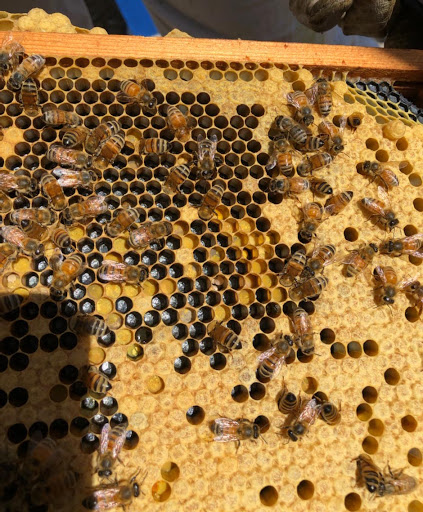Join Mike at Cutrignelli Fattoria for a conversation about pollinators and habitat gardening
EDITOR’S NOTE: THIS HIKE HAS BEEN POSTPONED DUE TO THE CORONAVIRUS SITUATION. NO ALTERNATE DATE HAS YET BEEN SET.

Photo courtesy Cutrignelli Fattoria
By Mike Monroe
During an open house at Johnson’s Garden Center, Sara Cutrignelli offered me a sample of her multi-floral honey produced by her honey bee colonies in San Martin. Again, my fondness for all things Italian kicked in as I noted her family heritage and the word “fattoria,” which translates into English as a farm or ranch. I must admit my sweet tooth makes it difficult for me to shy away from any form of sugar, but the combination of fresh honey sourced in our own backyard was irresistible.
We enjoyed a brief conversation and Sara was receptive to the idea of a column with the possibility of a tour of her beekeeping enterprise. Coincidentally, the news about the plight of insect pollinators, with the populations of some species of butterflies and bumble bees crashing, motivated me to learn more about what some have called the “insect apocalypse.” Sara was kind to invite me to her fattoria where we discussed how her family decided to become beekeepers and the support she received through her mentors with the Gilroy Beekeepers Association and the Santa Clara Valley Beekeepers Guild.
 We talked about the definitions of local honey and raw honey, how long does a male drone bee live, how hives are organized, the issue of colony collapse, commercial apiaries that provide hives throughout California for large scale agricultural pollination … I was buzzing with questions. Sara was very generous with her time further sparking my research into the broader context of how dependent we are upon our “native” insect and bird pollinators. Our visit to Cutrignelli Fattoria will be a real eye opener and a sweet experience for all. Here are some of the points of interest that we can talk about:
We talked about the definitions of local honey and raw honey, how long does a male drone bee live, how hives are organized, the issue of colony collapse, commercial apiaries that provide hives throughout California for large scale agricultural pollination … I was buzzing with questions. Sara was very generous with her time further sparking my research into the broader context of how dependent we are upon our “native” insect and bird pollinators. Our visit to Cutrignelli Fattoria will be a real eye opener and a sweet experience for all. Here are some of the points of interest that we can talk about:
-
Globally, there are about 20,000 species of bees. In California, we are home to 1,600 species. Only about 10 percent of bee species are social, and a smaller percentage construct hives. Most bees are solitary and live in individual nests tunneled into the soil.
-
Honeybees are not native to California. They originated from southern Asia, making their way to the Mediterranean area several millions of years ago. The European or western honey bee was introduced to North America about the same time the Pilgrims arrived then spreading into the Great Plains. Honeybees did not naturally cross the Rocky Mountains, rather Mormon pioneers transported the bees to Utah in the late 1840s and then during the Gold Rush the bees arrived aboard ships traveling to California.
-
Bumble bees do make honey; but because their colonies live for only one annual cycle bumble bees do not store honey for winter. Most of our native bees do not make any honey at all.
-
Honey is regurgitated nectar collected by worker honeybees. The nectar consists of mostly water which mixes with enzymes from the worker bees digestive system. The blend is transformed into thick, syrupy honey by the worker bees fanning the mixture which is stored in honeycombs for use during the winter season.
-
Of the 115 most commonly grown foods around the world, 87 crop varieties need animal pollinators such as bees, butterflies and birds. Varieties of squash, cocoa, orchard fruit are dependent upon pollinators. Crops that do not require pollinators for reproduction, such as rice and sugarcane, may not be as nutritious without the assistance of pollinators. Raspberry plants are self fruitful, but the berries are usually small and raspberry growers are grateful for the help of pollinators.
-
Significant declines in pollinator populations pose a real threat to production agriculture in terms of crop yield, quality and farm profitability.
-
As home gardeners, we can support our native pollinators by providing food, water, and cover places for our winged friends. Nectar flowers like California fuschia, salvias and sunflowers, which are native to our South County landscapes, are excellent members of a healthy garden. Sustainable gardening practices such as refraining from applying synthetic herbicides and pesticides plus developing rich soil structures and tilth will go a long way in support of our local pollinators.
Please join me at Cutrignelli Fattoria for a conversation about pollinators and habitat gardening — the birds and the bees. Keep on sauntering!
Mike Monroe coordinates local discovery outings to fun and friendly places like wineries, parks, museums in the Valley of Heart’s Delight. Visit thevalleyofheartsdelight.org.






